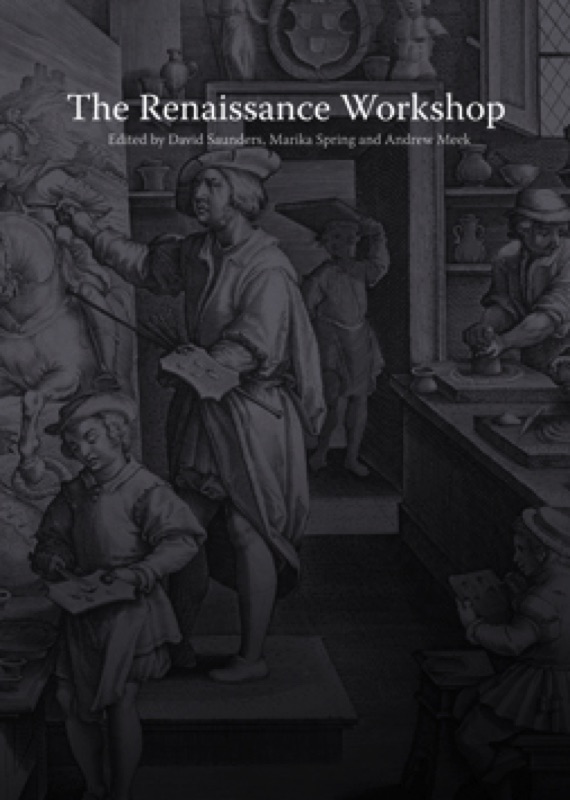The papers in this volume illustrate the way in which various types of technical evidence, derived from scientific examination and analysis, can contribute to the understanding of Renaissance workshop practices and the inter-relationships between different artists and artisans. These studies provide a vivid insight not only into the organization of craft and artistic endeavour in studios and workshops, but also into the everyday lives and concerns of those who ran and worked within them, showing that a great number of the challenges facing these artists and craftsmen are still relevant today. Originality and individuality were balanced against a sense and knowledge of what would sell, and the temptation to replicate the popular competed with the desire to innovate. Artists sought to make the best use of scarce, expensive materials and perhaps balanced the lower costs of those sourced or produced locally against the merits (in the guise of quality and exoticism) of more expensive imports.
While the business of the studio is a common theme, another is intercommunication and the spread of ideas – between individuals, among studios and across national boundaries. The examination of materials and techniques has enabled some of these connections to be made, providing an insight into the transfer of concepts and practices as regional and traditional styles were influenced through contacts between cultures and generations.
Foreword
Papers
Painting and illumination in early Renaissance Florence: the techniques of Lorenzo Monaco and his workshop
Paola Ricciardi, Michelle Facini and John K. Delaney
Workshop practice in Slovenian wall paintings from the fourteenth and fifteenth centuries
Anabelle Križnar
Replication and variation: Roccatagliata and the female nude
Shelley Sturman
Technical characteristics of bronze statuettes from the workshops of Antonio and Giovanni Francesco Susini
Dylan Smith
The workshop practice and the construction techniques of Florentine Renaissance crucifixes
Peter Stiberc
Altarpieces in Portugal: joinery techniques within the context of fifteenth- and sixteenth-century European workshop practice
Filipa Raposo Cordeiro
Early Renaissance altarpieces in Transylvania: materials and technological characteristics
Cristina Serendan, David Hradil, Janka Hradilová and Joseph Cannataci
The altarpiece of Saint Dominic of Silos by Bartolomé Bermejo: an example of painting practices during the early Spanish Renaissance
Dolores Gayo, Maite Jover and Laura Alba
Smoke and mirrors: the enhancement and simulation of gemstones in Renaissance Europe
Joanna Whalley
The San Giovanni altar from the Baptistery of Florence: the goldsmith’s workshop through the fourteenth and fifteenth centuries
Pamela Bonanni, Andrea Cagnini, Natalia Cavalca, Monica Galeotti, PierAndrea Mandò, Alessandro Migliori, Simone Porcinai and Marco VeritÃ
Christ carrying the Cross: a surviving sarga by Luis de Morales: technical examination and workshop practices
Rafael Romero and Adelina Illán
The Botteghe degli Artisti: artistic enterprise at the della Rovere and Medici courts in the late sixteenth century
Erma Hermens
Some ornament prints and their link with craftsmanship
Antony Griffiths
Moveable anatomies and print shop practice in sixteenth-century Strasbourg
Theresa Smith
Visual evidence for the use of carta lucida in the Italian Renaissance workshop
Maria Clelia Galassi
Evidence for workshop practices at the Tudor mint in the Tower of London
Justine Bayley and Harriet White
Sixteenth-century life-casting techniques: experimental reconstructions based on a preserved manuscript
Tonny Beentjes and Pamela H. Smith
Bernard Palissy: scientist and potter of the Renaissance in France
Anne Bouquillon, Françoise Barbe, Patrice Lehuédé, Jacques Castaing and Thierry Crépin-Leblond
Shorter contributions and posters
Stylus drawing in the Renaissance workshop: investigating leadpoint and blind stylus in a Leonardo drawing
Jenny Bescoby, Judith Rayner and Joanna Russell
Technical analysis of a Renaissance limestone altarpiece
Ana Bidarra, Pedro Antunes, Teresa Desterro, João Coroado and Fernando Rocha
Analyses of Renaissance Venetian enamelled glasses from the Musée du Louvre
Isabelle Biron, Marco Verità , Françoise Barbe and Rosa Barovier Mentasti
Conservation and preliminary study of the alabaster sculptures in the mausoleum of Jean V de Hénnin-Liétard at Boussu, Belgium
Judy De Roy
Nero di Bicci and the diffusion of cartoons between fifteenth-century Florentine workshops
Jennifer Diorio
Research on metallic material in liturgical textiles of the fifteenth and sixteenth centuries: studies of production technology
Livio Ferrazza, David Juanes and Mª Gertrudis Jaén
Striptease and dressing-up in Titian’s workshop: a technical comparison of the Young Girls in the Galleria Palatina, the Hermitage and the Kunsthistorisches Museum
Helen Glanville, Patrizia Riitano and Claudio Seccaroni
A treasured Renaissance manuscript, Les Vies des femmes celebres: laboratory investigations of the miniaturist Jean Pichore’s practices and techniques
Hélène Guicharnaud and Alain Duval
Grisaille materials and techniques in European Renaissance painted enamel objects: Limoges white, binding media, chiaroscuro and the interrelationship between crafts
Nuria López-Ribalta
Reassertion of a Renaissance jewel: the investigation and interpretation of two enamelled panels from the Wallace Collection
Andrew Meek, Jamie Hood and Jeremy Warren
Describing the elusive: a project for new perspectives on the practices and the resources of illuminators in the north of Europe from the fourteenth to the sixteenth century
Sylvie Neven
Distinctive materials in a late-sixteenth-century portrait
Libby Sheldon and Gabriella Macaro
Fra Bartolommeo and frescoes on tiles in fifteenth to sixteenth-century Florence
Deodato Tapete, Cristina Giannini and Fabio Fratini
Sixteenth-century Netherlandish workshop practices: technical investigation of the Copenhagen version of Christ Driving the Traders from the Temple
Hannah Tempest
Reviews
Las comunicaciones del congreso seleccionadas por CHARISMA, el Museo Británico o la Galería Nacional de Londres para esta publicación, presentan un excelente nivel en cuanto a la claridad de exposición, el interés del tema expuesto y el desarrollo de la metodología científica empleada en cada caso particular. Otro punto a tener en cuenta es la amplitud de técnicas artísticas afrontadas, que aportan una amplia visión sobre la magnitud del prodigioso fenómeno artístico que se produjo en el Renacimiento europeo.
Ge-conservación - 2014, pages 106-107
The essays make a good job of revealing markers, their motives and stimuli.
The Burlington Magazine - March 2015 pp 195-196
